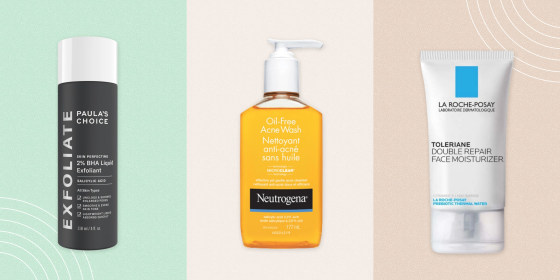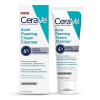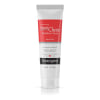How to treat cystic acne, according to dermatologists





You may be familiar with OTC acne treatments like benzoyl peroxide, salicylic acid and retinol (a vitamin A derivative) that can treat ordinary, run-of-the-mill pimples. However, these acne-fighting ingredients alone aren’t strong enough to cure cystic acne, our experts say.
Treating cystic acne requires a trip to the dermatologist and likely some type of medical intervention, experts say. Some of the most effective treatments include in-office cortisone injections and oral prescription medications like birth control pills, spironolactone and isotretinoin (usually known by its brand name, Accutane) to treat the underlying causes of the cysts. The most important takeaway is that cystic acne requires early intervention to prevent permanent scarring, says Weiss.
“Topically, it’s really hard to treat cystic acne. Over-the-counter products may help mitigate the inflammation and bring it down a bit. But making it go away is a lot trickier, and [OTC products] will not be effective if used alone,” says Dr. Mona Gohara, a board-certified dermatologist at Dermatology Physicians of Connecticut.
However, certain OTC acne treatments are beneficial when used in conjunction with more powerful prescription treatments. You should cleanse your skin with a wash that contains salicylic acid or alpha hydroxy acids (AHAs) like lactic acid at least a couple of times a week and use an oil-free moisturizer that’s gentle on the skin, says Dr. Tracy Evans, a board-certified dermatologist and medical director of Pacific Skin and Cosmetic Dermatology. Those with acne-prone skin should stick to noncomedogenic lotions, makeup and any other face products in order to not clog pores, says Weiss.
While OTC products can’t cure cystic acne, they can help improve your situation, dermatologists told me. When shopping for cystic acne treatments, consider the following factors:
Listed below are a few expert-recommended OTC products that can help treat cystic acne when used with oral medications and in-office treatments.
This foaming cleanser with 4% benzoyl peroxide is a great option if you have cystic acne on your face and around the body, says Weiss. It has added ingredients like hyaluronic acid and niacinamide that can be good for those dealing with acne due to their moisturizing and anti-inflammatory effects, she says. This wash gently removes dirt, excess oil and makeup, and it helps prevent new acne from forming, according to CeraVe. The noncomedogenic wash is also fragrance-free for those with sensitive skin.
This foaming cleanser comes recommended by Dr. Eileen Deignan, a board-certified dermatologist and chief of dermatology at Emerson Hospital, because it helps unclog pores and calm irritation from acne. The face wash has 2% salicylic acid, which helps remove dead skin cells and unclog pores, says Weiss. It’s suitable for most skin types because it’s free of oils, fragrances and parabens, according to the brand.
If you have oily or non-sensitive skin, you can use Panoxyl’s foaming wash to tame cystic acne on both your face and body. Its formula is 10% benzoyl peroxide, the highest concentration of the acne-fighting ingredient on this list. However, such a high concentration of benzoyl peroxide can be irritating to some people, especially those with sensitive skin, so you should introduce the product gradually into your skin care routine, according to Weiss.
This liquid, leave-on exfoliant, a favorite among our NBC Select staff, has 2% salicylic acid to help fight acne, unclog pores and remove dead skin. It’s also formulated with green tea to help soothe irritation, according to the brand. You can use this exfoliant up to twice daily, as long as your skin tolerates it.
This spot treatment gel contains 10% benzoyl peroxide, and you can apply it directly on top of acne to reduce its size and redness, as well as actively fight future breakouts, says Gohara, who usually recommends this product for her patients with cystic acne. Neutrogena recommends applying a thin layer of the acne gel one to three times daily.
Products that contain adapalene — the only topical retinoid available over-the-counter — can be helpful when used in conjunction with other prescription treatments, and can cure inflammation, deep clean pores and prevent new pimples from forming, says Weiss. The brand recommends applying a thin layer of Differin Gel to the affected areas of the skin after cleansing and before moisturizing.
Another adapalene product Weiss recommends is La Roche-Posay’s Effaclar Adapalene Gel, which contains 0.1% adapalene to help unclog pores and fight acne. The gel is fragrance- and oil–free, and it’s noncomedogenic.
“For my acne prone patients, I recommend moisturizing with a gentle, noncomedogenic moisturizer to keep their skin barrier intact,” says Weiss. This daily moisturizing lotion from expert-favorite brand CeraVe is good for sensitive skin because it’s fragrance-free and accepted by the National Eczema Association. The lotion has hyaluronic acid and ceramides to help retain the skin’s natural moisture for up to 24 hours, according to CeraVe.
One of our favorite expert-recommended face moisturizers for acne-prone skin and rosacea, this La Roche-Posay moisturizer is both gentle enough for sensitive skin and has ingredients like niacinamide and ceramides to keep it hydrated, according to the brand. I use this moisturizer both day and night on my sensitive, acne- and rosacea-prone skin because it helps soothe my constant redness and inflammation. The moisturizer offers 48-hour hydration and can be used on the face, neck and hands, according to La Roche-Posay.
Cystic acne is a type of inflammatory acne that causes deep, painful lesions underneath the skin due to the accumulation of oil, bacteria and dead skin cells. Much like regular acne, cysts can range from mild (you might develop one or two cysts on your chin around your menstrual cycle, for example) to severe, which can affect the entire face and even the chest and upper back, says Weiss.
Hormonal changes or triggers related to puberty, menopause and pregnancy, underlying medical conditions like polycystic ovary syndrome (PCOS), stress and genetics can all cause cystic acne, according to Weiss. Certain people may also have an increased risk of developing cystic acne, including those with a family history of cystic acne and teenagers going through puberty, she says.
There are three common active ingredients in OTC products that can help reduce inflammation caused by cystic acne: salicylic acid, benzoyl peroxide and adapalene. Though they likely won’t completely treat cystic acne on their own, these active ingredients can be helpful if you use them with in-office treatments and prescription medications. Keep in mind, however, that all of these ingredients can cause irritation, so they may not be suitable for sensitive skin, and you should introduce them gradually into your skin care routine.
Salicylic acid is a chemical exfoliant and beta hydroxy acid (BHA) that helps fight acne by targeting excess oil production, unclogging pores and removing dead skin cells, says Weiss. You can typically find 2% salicylic acid in creams, washes and lotions.
Benzoyl peroxide specifically fights acne-causing bacteria to help reduce inflammation and the appearance of acne lesions, according to Weiss. You’ll often see products with very high concentrations of benzoyl peroxide (usually around 10%), but there isn’t much evidence to suggest that higher strengths are more effective at treating acne.
“There are actually some studies that show that 2.5% benzoyl peroxide and 10% benzoyl peroxide have a minimal difference in terms of their efficacy in acne treatments,” says Gohara. People with cystic acne that experience sensitivity or dryness may be able to tolerate the lower strength ingredients better, says Weiss.
Retinoids are more powerful acne treatments that can be effective at reducing inflammation. Topical retinoids help increase skin cell turnover and clear out clogged pores, which may be contributing to the initial cause of cystic acne, says Weiss. While prescription retinoid gels and creams are the most effective at treating cystic acne, adapalene — a topical OTC retinoid treatment — works well to regulate the turnover of cells lining the pores to reduce clogging.
Keep in mind that adapalene can be very drying, so you should introduce this ingredient gradually into your skin care routine, using a small amount and moisturizing afterward, according to Gohara. “Your skin is already irritated with the cystic acne, the last thing you want to do is stoke the fire,” she says.
At NBC Select, we work with experts who have specialized knowledge and authority based on relevant training and/or experience. We also take steps to ensure that all expert advice and recommendations are made independently and with no undisclosed financial conflicts of interest.
I'm an updates editor at NBC Select who has covered a wide range of skin care topics, including face sunscreens, rosacea and keratosis pilaris treatments. For this article, I spoke to four dermatologists about how to treat cystic acne and highlighted their recommendations for the best over-the-counter products to consider.
Catch up on NBC Select’s in-depth coverage of tech and tools, wellness and more, and follow us on Facebook, Instagram, Twitter and TikTok to stay up to date.